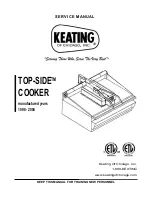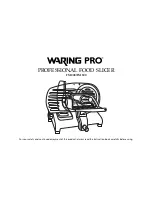
28
Care and cleaning
Only clean the appliance when it has been switched off.
Ensure that the sealing bar in the vacuuming chamber
has cooled down.
m
Risk of burns!
The sealing bar in the vacuuming chamber becomes
extremely hot if the appliance is used frequently and
there are long heat-sealing times. Never touch the hot
sealing bar. Keep children away from the appliance.
During cleaning, ensure that no water or other liquid
gets into the vacuum-sealing compartment or, in
particular, into the vacuum pump's air outlet. Never
spray the inside or outside of the appliance with water.
Do not use a high-pressure cleaner or steam jet cleaner.
Only use natural cleaning agents, such as washing-up
liquid and water. Do not use any abrasive materials or
cleaning agents that contain alcohol.
Clean the appliance using only a damp cloth.
Do not use any abrasive sponges that may scratch or
any glass scrapers.
Note:
Leave the appliance and accessory parts to fully
dry after they have been cleaned.
Glass front and glass lid
Clean the glass front and the glass lid with glass
cleaner and a soft cloth.
Do not use any abrasive sponges that may scratch or
any glass scrapers.
Stainless steel vacuuming chamber
Always remove flecks of limescale, grease, starch and
albumin (e.g. egg white) immediately. Corrosion can
form under these patches or splashes. Clean with water
and some washing-up liquid. Dry the surface with a soft
cloth.
Plastic control panel
Do not use any abrasive sponges that may scratch or
any glass scrapers.
Sealing bar
Remove the remaining film from the sealing bar.
Never use abrasive cleaning agents to clean the sealing
bar. Use a soft cloth.
The sealing baris not suitable for dishwashers.
Raised vacuuming platform
Rinse the raised vacuuming platform by hand.
External vacuuming adaptor, adaptor
for bottle plugs and plugs for
vacuuming bottles
Rinse the adaptors and plugs for vacuuming bottles by
hand. They are not suitable for dishwashers.
Vacuum hose
Rinse the vacuum hose by hand. It is not suitable for
dishwashers.
29
What to do in the event of a fault
Faults often have simple explanations. Before you call
our after-sales service, please read the information in
the table below.
Note:
Any repair work must only be carried out by
qualified experts. Incorrect repairs to your appliance
may present considerable risks for the user.
Fault
Error
Causes
Possible remedy
The
…
symbol will appear
after a few seconds.
The vacuum cannot be
created properly.
The glass lid has not been closed
properly.
Open and close the glass lid again.
When doing so, lightly press on the
glass lid for the first few seconds.
The seal on the glass lid is not fitted
properly or is defective.
Check the seal.
The seal on the glass lid has
deformed.
Gently press the seal to straighten it
out.
The lid on the external vacuum-seal-
ing container has not been closed
properly.
Check the position of the vacuum-
sealing lid. Only use suitable vac-
uum-sealing containers.
The external vacuum-sealing con-
nection is not positioned correctly
on the vacuum-sealing chamber's
air outlet.
Check the position of the external
vacuum-sealing connection.
The
…
symbol will appear
after the pump has been
running for 2 minutes.
It is taking too long to cre-
ate a vacuum. Your
selected vacuum-sealing
level cannot be reached.
As the temperature rises, liquids
begin to boil. At this point, the pro-
cess of creating a vacuum stops.
Only vacuum-seal cold liquids.
If the vacuum-sealing chamber is
wet, wipe it dry.
Heat-seal the vacuum-sealing bag
early if large bubbles form.
Select a lower vacuum-sealing level.
The vacuum-sealing pro-
cess will not start. The
²
symbol does not
appear even though the lid
is closed.
The appliance is not
detecting the lid.
The door switch on the glass lid is
missing or is not being detected by
the appliance.
Call the after-sales service.
If you try to operate the
appliance several times in
succession, the vacuum-
sealing process seems to
run as normal but the bag
is not heat-sealed.
The thermal switch on the heat-seal-
ing transformer has been triggered.
Allow the appliance to cool for at
least 10 minutes. Then try again.
Allow the appliance to cool for at
least 2 minutes between vacuum-
sealing operations.
The vacuum-sealing pro-
cess is taking longer and
longer.
There is too much moisture in the
pump system.
The appliance monitors the vacuum-
sealing as it progresses. If too much
liquid is retained in the pump oil,
the
¢
symbol will appear. Initiate
drying.
The pump system is extremely hot.
Allow the appliance to cool and
then try again.
After the drying proce-
dure, the appliance dis-
plays the
¢
and
…
symbols.
One drying cycle alone was not suf-
ficient.
Wait until the
…
symbol is no
longer lit up. Then start another dry-
ing cycle.




































